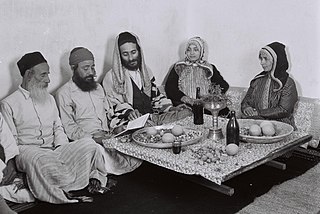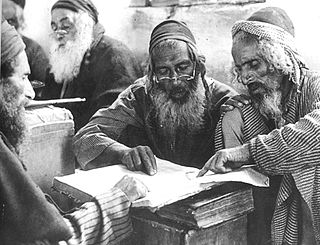Related Research Articles

Rabbinic literature, in its broadest sense, is the entire spectrum of rabbinic writings throughout Jewish history. However, the term often refers specifically to literature from the Talmudic era, as opposed to medieval and modern rabbinic writings, and thus corresponds with the Hebrew term Sifrut Chazal. This more specific sense of "Rabbinic literature"—referring to the Talmudim, Midrashim, and related writings, but hardly ever to later texts—is how the term is generally intended when used in contemporary academic writing. The terms mefareshim and parshanim (commentaries/commentators) almost always refer to later, post-Talmudic writers of rabbinic glosses on Biblical and Talmudic texts.

Yemenite Jews, also known as Yemeni Jews or Teimanim, are those Jews who live, or once lived, in Yemen, and their descendants maintaining their customs. Between June 1949 and September 1950, the overwhelming majority of the country's Jewish population immigrated to Israel in Operation Magic Carpet. After several waves of persecution, the vast majority of Yemenite Jews now live in Israel, while smaller communities live in the United States and elsewhere. As of 2022, only one Jew remained in Yemen.

The Mishneh Torah, also known as Sefer Yad ha-Hazaka, is a code of Rabbinic Jewish religious law (halakha) authored by Maimonides. The Mishneh Torah was compiled between 1170 and 1180 CE, while Maimonides was living in Egypt, and is regarded as Maimonides' magnum opus. Accordingly, later sources simply refer to the work as "Maimon", "Maimonides", or "RaMBaM", although Maimonides composed other works.

Yemenite Hebrew, also referred to as Temani Hebrew, is the pronunciation system for Hebrew traditionally used by Yemenite Jews. Yemenite Hebrew has been studied by language scholars, many of whom believe it to retain older phonetic and grammatical features lost elsewhere. Yemenite speakers of Hebrew have garnered considerable praise from language purists because of their use of grammatical features from classical Hebrew. Tunisian rabbi and scholar, Rabbi Meir Mazuz, once said of Yemenites that they are good grammarians.
Nethanel ben Isaiah was a Yemenite Jewish rabbi, Biblical commentator and poet of the fourteenth century. He is best known as the author of a homiletic commentary on the Torah entitled Nur al-Zulm wa-Mashbah al-Hikm, translated into Hebrew as Sefer Me'or ha-Afelah.

Abraham Maimonides was the son of Maimonides and succeeded his father as nagid of the Egyptian Jewish community.
Yosef Qafiḥ, widely known as Rabbi Yosef Kapach, was a Yemenite-Israeli authority on Jewish religious law (halakha), a dayan of the Supreme Rabbinical Court in Israel, and one of the foremost leaders of the Yemenite Jewish community in Israel, where he was sought after by non-Yemenites as well. He is widely known for his editions and translations of the works of Maimonides, Saadia Gaon, and other early rabbinic authorities (Rishonim), particularly his restoration of the Mishneh Torah from old Yemenite manuscripts and his accompanying commentary culled from close to 300 additional commentators and with original insights. He was the grandson of Rabbi Yiḥyah Qafiḥ, a prominent Yemenite leader and founder of the Dor Deah movement in Yemen. Qafih was the recipient of many awards, as well as an Honorary Doctorate from Bar-Ilan University.

Midrash HaGadol or The Great Midrash is a work of aggaddic midrash, expanding on the narratives of the Torah, which was written by David ben Amram Adani of Yemen.

Adeni Jews, or Adenite Jews are the historical Jewish community which resided in the port city of Aden. Adenite culture became distinct from other Yemenite Jewish culture due to British control of the city and Indian-Iraqi influence as well as recent arrivals from Persia and Egypt. Although they were separated, Adeni Jews depended on the greater Yemenite community for spiritual guidance, receiving their authorizations from Yemeni rabbis. Virtually the entire population emigrated from Aden between June 1947 and September 1967. As of 2004, there were 6,000 Adenites in Israel, and 1,500 in London.
The following outline is provided as an overview of and topical guide to Judaism:

The Mawza Exile is considered the single most traumatic event experienced collectively by the Jews of Yemen, in which Jews living in nearly all cities and towns throughout Yemen were banished by decree of the king, Imām al-Mahdi Ahmad, and sent to a dry and barren region of the country named Mawzaʻ to withstand their fate or to die. Only a few communities, viz., those Jewish inhabitants who lived in the far eastern quarters of Yemen were spared this fate by virtue of their Arab patrons who refused to obey the king's orders. Many would die along the route and while confined to the hot and arid conditions of this forbidding terrain. After one year in exile, the exiles were called back to perform their usual tasks and labors for the indigenous Arab populations, who had been deprived of goods and services on account of their exile.
The Baladi-rite Prayer is the oldest known prayer-rite used by Yemenite Jews, transcribed in a prayer book known as a tiklāl in Yemenite Jewish parlance. "Baladi", as a term applied to the prayer-rite, was not used until prayer books arrived in Yemen in the Sephardic-rite.

Avraham Al-Naddaf (1866–1940), the son of Ḥayim b. Salem Al-Naddaf, was a Yemenite rabbi and scholar who immigrated to Ottoman Palestine in 1891, eventually becoming one of the members of the Yemenite rabbinical court (Beit-Din) established in Jerusalem in 1908, and active in public affairs. His maternal grandfather was Rabbi Yiḥya Badiḥi (1803–1887), the renowned sage and author of the Questions & Responsa, Ḥen Ṭov, and a commentary on the laws of ritual slaughter of livestock, Leḥem Todah, who served as the head of Sanaa's largest seat of learning (yeshiva), held in the synagogue, Bayt Saleḥ, before he was forced to flee from Sana'a in 1846 on account of the tyrant, Abū-Zayid b. Ḥasan al-Miṣrī, who persecuted the Jews under the Imam Al-Mutawakkil Muhammad.
Yihye Bashiri, also spelt Yahya al-Bashiri, known by his pen-name Avner bar Ner ha-Sharoni, and by the acronym Maharib, was a Yemenite Rabbi, professional scrivener and sofer of the Masoretic Text whose works of Hebrew manuscripts now account for many now stored in public libraries across the globe, including the Jewish Theological Seminary of America, Cambridge University Library, the Russian State Library and the Hebrew Union College-Jewish Institute of Religion, et al. Rabbi Yiḥyah Salaḥ coined him the epithet, "the great scribe of the Law." A man of uncommon piety, he is also known for an act of intervention on behalf of his community in Yemen, which brought miraculous deliverance to the Jews of Sana'a when they stood in danger of annihilation by the king, on account of libel and slander brought against them.
Yemenite Jewish poetry, often referred to as "paraliturgical poetry" because of its religious nature, has been an integral part of Yemenite Jewish culture since time immemorial. The Jews of Yemen have preserved a well-defined singing arrangement which not only includes the very poetic creation itself, but also involves a vocal and dance performance, accompanied in certain villages outside Sana'a by drumming on an empty tin-can (tanakeh) or a copper tray. The Jews of Yemen, maintaining strict adherence to Talmudic and Maimonidean halakha, observed the gezeirah which prohibited playing musical instruments, and "instead of developing the playing of musical instruments, they perfected singing and rhythm." This arrangement was integrated into the walks of life familiar to the Jews of Yemen. The texts used in the arrangement were put down in writing and later included in separate song collections (dīwāns). The social strictures and norms in Yemenite Jewish culture provide for separate settings for men and for women, where the sexes are never mixed. Men’s song usually expressed the national aspirations of the Jewish people, and it was far removed from the singing associated with the Muslim environment, whereas folk songs of Jewish women were sung by rote memory and expressed the happiness and sorrows inherent in their daily life and was, as a rule, closer to that of Muslim women.
Yehoshua Hanagid, alternative spelling: Jehoshua Hannagid (1310–1355), was a rabbinic scholar and judge, who began to serve as the Nagid in Cairo, Egypt, at the age of twenty-four. He was the fifth-generation descendant of Rabbi Moshe ben Maimon, the great Spanish Rabbi and philosopher. His full lineage is reckoned as Yehoshua, the son of Avraham, the son of David, the son of Avraham, the son Moshe ben Maimon.

Yemenite scrolls of the Law containing the Five Books of Moses represent one of three authoritative scribal traditions for the transmission of the Torah, the other two being the Ashkenazi and Sephardic traditions that slightly differ. While all three traditions purport to follow the Masoretic traditions of Aaron ben Moses ben Asher, slight differences between the three major traditions have developed over the years. Biblical texts proofread by ben Asher survive in two extant codices, the latter said to have only been patterned after texts proofread by Ben Asher. The former work, although more precise, was partially lost following its removal from Aleppo in 1947.
Amram Qorah was the last Chief Rabbi in Yemen, assuming this role in 1934, after the death of Rabbi Yihya al-Abyadh, Resh Methivta, and which role he held for approximately two years. He is the author of the book, Sa'arat Teman, published post-mortem by the author's son, a book that documents the history of the Jews of Yemen and their culture for a little over 250 years, from the Mawza exile to the mass-immigration of Yemenite Jews to Israel in the mid-20th century.
Midrash ha-Ḥefez, or "Commentary of the Book of the Law", is a Hebrew midrash written by the physician and Rabbi, Yihye ibn Suleiman al-Dhamari, otherwise known as Zechariah ben Solomon ha-Rofé, which he began to write in 1430 in Yemen and concluded some years later. The work contains commentaries and homilies on the Pentateuch, Book of Esther, and Book of Lamentations, as well as a commentary on the haftarot, written in a mixture of Hebrew, Aramaic and Judeo-Arabic. A commentary exists under the name "al-Durra al-Muntakhaba".
Zechariah ha-Rofé, or "Zechariah the physician", also known as Yiḥye al-Ṭabib, was a Yemenite Jewish scholar of the 15th-century, renowned for his authorship of the work, Midrash ha-Ḥefetz, a commentary and collection of homilies on the Five Books of Moses (Pentateuch) and on the readings from the Prophets which he began to write in 1430, and concluded some years later. The work is unique in that he incorporates therein Aristotelian and Platonic philosophy translated from Greek into Arabic, along with the teachings of Maimonides (1138–1204), and the philosophical notions expressed by Abu Nasr al-Farabi, whom he cites in his work. The author makes use of three languages in his discourse, Hebrew, Judeo-Arabic, and Aramaic, interchanging between them whenever he sees fit. All sections of the Judeo-Arabic texts have been translated into Hebrew by Meir Havazelet in his 1990–1992 revised editions of the work, to accommodate a largely Hebrew-speaking readership.
References
- 1 2 3 Yehuda Ratzaby, ed. (1971), "Adani, David ben Amram", Encyclopaedia Judaica, vol. 2, Jerusalem: Keter Publishing House, p. 250
- ↑ Neubauer, A. (1893), The Jewish Quarterly Review 5, p. 339
- 1 2 3 Tobi, et al. (2000), p. 197
- 1 2 Ratzaby (1978), p. 103
- ↑ Cf. Jewish Theological Seminary of New York (Ms. 10709)
- ↑ Ratzaby (1989), p. 15 (Preface)
- ↑ Excerpt from Midrash HaGadol, on Genesis, parashat Vayechi, p. 794